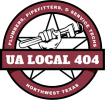Project Labor Agreements provide UA Local 404 labor to taxpayers
What does a Project Labor Agreement mean for tradesmen and tradeswomen?
A Project Labor Agreement (PLA), sometimes called a Community Benefits Agreement, is a Collective Bargaining Agreement (CBA) between labor unions and contractors or a project owner for a specific project. These agreements outline the terms of employment for a particular project and can be applied when union and nonunion labor is used on the same project.
How do PLAs benefit local taxpayers?
PLAs are used on publicly funded projects as a way to protect the investment of taxpayers. They settle any potential labor disputes at the bargaining level and ensure taxpayer dollars are spent on quality labor.
Frequently, language is written into the PLA to cover labor disputes, which removes the possibility of a labor strike and keeps the project moving on time.
PLAs ensure tax dollars stay in the community through the use of local labor
When it comes to publicly funded projects, PLAs ensure tax dollars stay within the community. By requiring the use of local tradesmen and tradeswomen, a PLA will keep tax dollars in the community and prevent them from going to out-of-state workers, who will take money back to their home state. In some instances, language within the PLA may require a percentage of the work be performed by residents of a city or county, minorities, women and or other criteria. Additionally, a PLA may require bids go to a small business or minority-owned contractor.
PLAs reduce safety risks for UA Local 404 members working on the project
By requiring a level of collective bargaining, builders are typically left with the best contractors in the area who adhere to all safety guidelines and hire a workforce with industry-leading OSHA safety credentials. A shutdown due to an injury or death will not only push the timeline back, but will lead to extra costs as well.
A PLA helps ensure tradesmen and tradeswomen return home safely to their families at the end of their shift.




